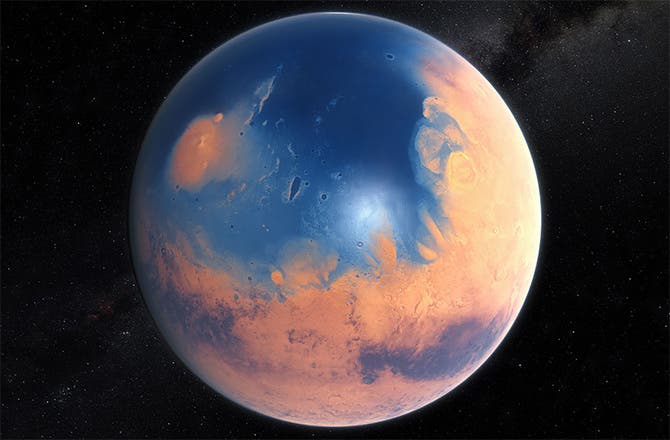Scientists have found more tantalizing evidence regarding Mars’ wet past – according to new research, the Red Planet may have once had a huge ocean, containing 5 million cubic miles of water with a depth of over a mile.

This artist’s impression shows how Mars may have looked about four billion years ago. The young planet Mars would have had enough water to cover its entire surface in a liquid layer about 140 meters deep, but it is more likely that the liquid would have pooled to form an ocean occupying almost half of Mars’s northern hemisphere. ESO/M. KORNMESSER/N. RISINGER (SKYSURVEY.ORG)
It’s no secret by now that Mars had liquid water on its surface – Curiosity found water on Mars and even traces of flowing water, and there is also evidence that Mars had seas for millions of years. But how much water did it have? A new study concluded that a Martian ocean covered an area about as big as the Atlantic Ocean, greatly raising the potential for life on Mars.
“Our study provides a solid estimate of how much water Mars once had, by determining how much water was lost to space,” said Geronimo Villanueva, of NASA’s Goddard Space Flight Center in Greenbelt, Maryland, and lead author of the new paper, in an ESO news release. “With this work, we can better understand the history of water on Mars.”
The study analyzed chemical “signatures” in the Martian atmosphere, over a period of six years. Basically, with the ESO’s Very Large Telescope (in Chile) and instruments at the W. M. Keck Observatory and the NASA Infrared Telescope Facility (both on Mauna Kea in Hawaii), he studied the distribution of water molecules in the Martian atmosphere.
But he didn’t look just for regular water – he looked for two types of water: “normal” water (H2O) and HDO, or semi-heavy water, a naturally occurring variation in which one hydrogen atom is replaced by a heavier form, called deuterium. Basically, the HDO water is heavier and therefore less easily lost into space through evaporation. So the more water evaporates, the more H2O will be lost in space and HDO will remain in the weak Martian atmosphere – therefore a greater HDO to H2O water indicates a higher rate of evaporation. This in turn allows the amount of water on Mars at earlier times to be estimated.
Based on these calculations, Mars must have lost a volume of water 6.5 times larger than the present polar caps to provide such a high level of enrichment. The volume of Mars’s early ocean must have been at least 20 million cubic kilometres (5 million cubic miles). The ocean would have likely occupied a fifth of Mars.
“With Mars losing that much water, the planet was very likely wet for a longer period of time than previously thought, suggesting the planet might have been habitable for longer,” said Michael Mumma, a senior scientist at Goddard and the second author on the paper.
It’s possible that Mars had even more water, but some of it was locked beneath its surface.
“With Mars losing that much water, the planet was very likely wet for a longer period of time than previously thought, suggesting the planet might have been habitable for longer,” said Michael Mumma, also of NASA’s Goddard Space Flight Center.
lli Kaeufl, of the European Southern Observatory and co-author of the paper, added:
“I am again overwhelmed by how much power there is in remote sensing on other planets using astronomical telescopes: we found an ancient ocean more than 100 million kilometers away!”
Journal Reference: G. L. Villanueva et al. Strong water isotopic anomalies in the martian atmosphere: Probing current and ancient reservoirs. DOI: 10.1126/science.aaa3630









